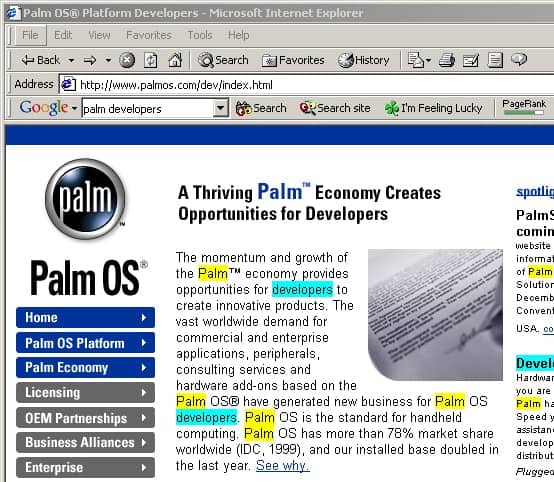
Google regularly updates its search algorithm. You can read what has happened in recent years in our Google update history.
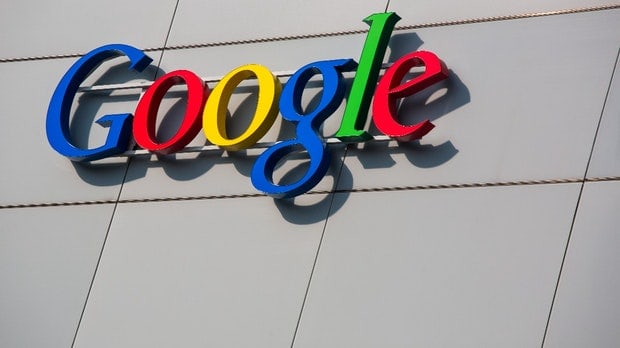
Google is continuously working on optimizing its search algorithm and has made several updates in recent years. Some are hardly significant and happen almost every day; others have driven site operators to the brink of madness. It is often not even possible to say precisely what an update specifically included since Google rarely makes official statements about updates. The focus is always on trying to help users optimally with their search queries. For site operators, this means: just don’t stop! But that’s precisely what makes the SEO game so exciting, isn’t it?
We take a look back at the updates that Google has brought us since 2000.
Google updates from 2000 and 2001
In December 2000, Google launched the Google Toolbar. This browser plugin enables users to use Google search directly from any page. The toolbar also contained the Google page rank, which marked the importance of a page. Google got the SEO stone rolling.
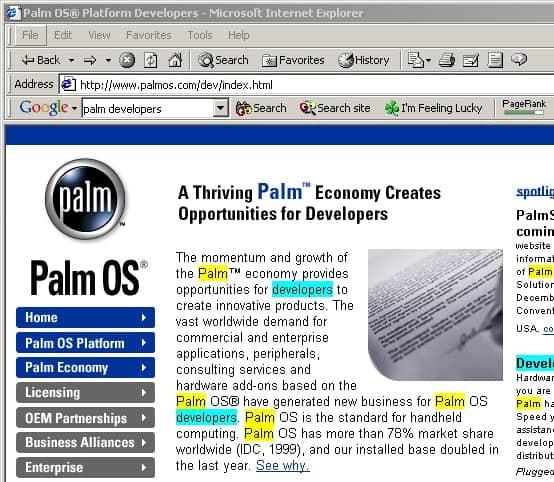
The Google Toolbar in 2000. (Image: Google Press)
In July 2001, the Google image search was launched. It initially has access to around 250 million indexed images. For comparison: Today, there are over 50 billion indexed images.
Google updates from 2002
The first documented Google algorithm update hit the webmasters in September 2002. Some site operators, which previously occupied top 10 positions, plummeted. The update triggered massive discussions: In the Webmaster World Forum, there were over 400 posts after just one day. The update concerned the relevance assessment and the meaning of anchor texts. There was no official statement from Google – not for the last time in the long history of Google updates.
Google updates from 2003
In 2003, the Google update carousel got going, starting with the so-called Boston update in February 2003. The update got its name from SES in Boston, where Google announced the changes. The update includes an expansion of the index and small modifications to the algorithm, which should be made regularly in the future.
In April 2003, the Cassandra update took place, which was carried out against massive links from and to other sites owned by the site operator as well as hidden links and hidden text.
Already in May 2003 was followed by Dominic update. Precisely what it contained remained unclear, but several fluctuations in the search results could be observed.
With the Esmeralda update in June 2003, Google heralded the end of the monthly updates. The update only affected the Google Search infrastructure.
With the Fritz update, the so-called Google Dance, i.e. the monthly updating of the algorithm, finally came to an end in July 2003. Google started rolling out changes step by step, which allowed the index to change daily.
The indexing of the website was changed with the Supplemental Index in September 2003. Instead of just indexing the content in the source text of a page, additional information and documents could now be saved in a separate index. In 2007, Google discontinued this index.
The Florida update in November 2003 was directed against Webspam. Many blackhat methods, like keyword stuffing, became ineffective.
Google updates from 2004
The Austin update in January 2004 continued the work of Florida, targeting keyword stuffing in meta tags and hidden text. Relevance became more and more on the topic of search engine optimization.
Thanks to the brandy update in February 2004, we owe that Google can also understand synonyms. With latent semantic indexing (LSI), indexing no longer followed the sheer keyword density, but the thematic relevance of a page. Anchor texts and the link neighbourhood also became more critical.
Google updates from 2005
In January 2005, Google, Yahoo and Microsoft (Bing) introduced the Nofollow attribute. With this attribute, page operators can tell the search engines not to pass on the link power to a linked page, which is particularly advantageous for spammy blog comments.
Fluctuations in the search results were again noticed in February 2005. What exactly was behind the Allegra update, however, remained unclear. Webmasters suspected that suspicious links, in particular, were punished and the LSI was improved.
The bourbon update was announced in May 2005 by a user named Google guy (probably Matt Cutts). The update affected the handling of internal and external duplicate content.
In June 2005, Google started to introduce personalized search, which initially took users’ search history into account when ranking. In the same month, Google enabled operators of the first time to submit an XML sitemap to Google using the search console.
Links of poor quality were targeted again in October 2005 with the Jagger update. The rollout took place in three stages and led in part to massive ranking losses if the link structure was primarily based on link farms, reciprocal link exchange and paid links.
Technically speaking, the Big Daddy update in December 2005 was not an update of the algorithm itself. Google installed new software that caused changes in indexing and crawling.
Updates from 2006
Compared to previous years, it was hushed in the Google world this year. In November 2006, Google made changes to the supplement index. The handling of filtered pages has been fundamentally changed. According to Google, the update not only served to penalize individual pages, even if the effects amounted to a penalty for some page operators.
Updates from 2007
In May 2007, Google said goodbye to the search result list with ten entries that was common at the time. News, videos, images and local search results were integrated into the search results list and shaped the image of Google search that we know today.
With the Buffy update, various small changes to the search algorithm were made in June 2007. The update owes its name to outgoing Google employee Vanessa Fox, who was an avowed Buffy fan.
Google updates from 2008
The Dewey update in April 2008 caused a lot of discussion in the SEO scene. What precisely the update did was unclear. It was striking, however, that the search results were different, depending on which Google server played them.
In August 2008, Google finally introduced the Google Suggest auto-completion feature. A first step that made longer searches (long-tail) more accessible.
Google updates from 2009
In February 2009, Google, Yahoo and Microsoft announced support for the Canonical Tag. With this tag, site operators can mark content as duplicate content and mark the linked page as original. In the same month, the Vince update was rolled out, also known as a brand update. This preferred brands in the search result so that users can find relevant content faster when searching for brands.
With the introduction of real-time search in December 2009, Google included real-time information from Twitter, Facebook, blogs and news pages in the search results.
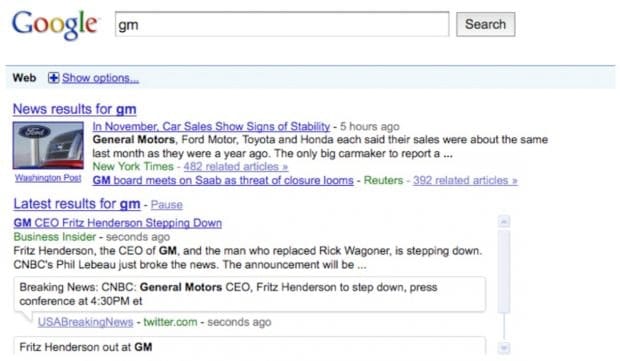
The Google Real-Time Search in 2008. (Image: Google)
Google updates from 2010
From the end of April to the beginning of May 2010, many website operators experienced a noticeable loss of traffic. The reason for this was the so-called May Day Update, which primarily concerned long-tail search queries and affected pages with inadequate or inferior content. Google employee Matt Cutts commented on this quality update in a YouTube video:
After several tests, the Caffeine update in June 2010 rolled out a new indexing system. Web content could now be indexed much faster, so users get 50 per cent more up-to-date search results.
In November 2010, Google introduced the instant preview function. Using a magnifying glass icon, users could preview the website in the search results without having to visit them. Google wanted to focus on usability and landing page designs. However, the users were less interested because the function was discontinued in 2013 due to insufficient use.
In December 2010, Google and Microsoft confirmed that social signals would play a role in ranking in the future.
Google updates from 2011
With the Panda update, which was rolled out in February 2011, Google launched a large-scale quality offensive. The update was aimed primarily at content farms and sites with thin content, a high percentage of advertising and other quality problems. About twelve per cent of English-language searches were affected. In the course of the year, the update was rolled out globally and adapted nine times.
In June 2011, Google, Yahoo and Microsoft announced that they would use schema.org, a common standard for structured data. They are designed to help crawlers understand the content of a page even better and enable rich snippets to be displayed.
With the Expanded Sitelinks, Google will once again change the look of the search results in August 2011. The update primarily affects search queries about brands. It is now no longer only a URL that is displayed in the search results, but also other essential subpages of the domain.
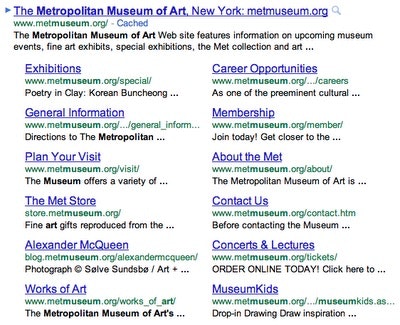
The Expanded Sitelinks were rolled out in August 2011. (Image: Google)
The freshness update in November 2011 ensured that more current and newer results are preferred depending on the search query. According to Google, about six to ten per cent of search queries were affected. In the same month, Google announced an updated set that included several minor changes. Among other things, search results from English are translated for languages that are not widely used.
Google updates from 2012
The page layout update in January 2012 focuses on the relationship between content and advertisements in the directly visible area of a page (above the fold). If users have to scroll too long to get to the critical content of a page, this hurts the ranking.
In February 2012, Google integrated content from Google Places into the search results for the first time with the Venice update, further enhancing local search. Google launched a whole bunch of 50 minor updates in March 2012. Among other things, the analysis of link texts and the identification of high-quality content were improved.
With the Penguin update, Google presented the next animal algorithm change in April 2012. The company was tough on webspam. Pages whose SEO techniques contradict the webmaster guidelines were particularly affected. Several minor adjustments were made during the year.
In May 2012, Google introduced the knowledge graph. This integrated further information and additional objects for a search query into the search results. In December 2012, the knowledge graph was expanded to include non-English search results.
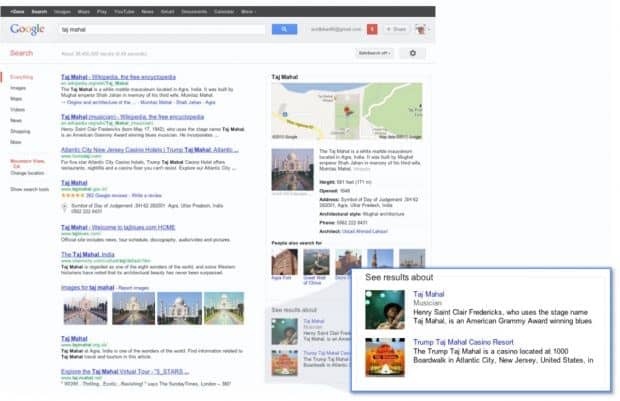
The knowledge graph in May 2012. (Image: Google)
Pages that violate copyright law were punished in August 2012 by the Pirate update. Around the same time, Google confirmed a set of 86 minor updates, which primarily gave trusted sites a ranking advantage. In August, the number of organic search results displayed on the first page was also reduced from ten to seven.
The EMD update (Exact Match Domain) in October 2012 significantly reduced the meaning of Exact Match domains, i.e. domains that contain precisely the keyword or the keyword combination in the URL. In October there was also a second-page layout update, which was an improved version of the first updates.
Google updates from 2013
The Panda and Penguin updates also received several upgrades this year, which made Webspam even better punished. In May 2013, numerous site operators also reported severe losses invisibility. Since Google confirmed no update and the changes affected many very different pages, we speak of a phantom update.
In June 2013, Google introduced an algorithm change with the Payday Loan Update, which penalized niche sites that were particularly exposed to spam, to improve the search results for spam-prone searches such as “credit”.
Google introduced a further improvement in semantic search with the Hummingbird update in August 2013. The new algorithm should be able to interpret search queries even better to be ready to serve not only individual search terms but also the possible search intentions of the user.
Google updates from 2014
The further development of Panda dominated the first half of 2014, Penguin and Payday-Loan in order to include pages with high-quality content in the search results better.
In July 2014, another animal moved into the Google Zoo with the Pigeon update. The update linked the core algorithm more closely to the local search algorithm to be able to provide even more relevant results for search queries with a local reference. Pigeon will also be rolled out in the UK, Canada and Australia at the end of the year.
With a security update in August 2014, Google makes secure encryption of websites a ranking signal. HTTPS sites will be preferred in the future. Four years later, Google finally started marking HTTP pages as unsafe in the Chrome browser.
Google updates from 2015
In February 2015, site operators reported some sharp traffic fluctuations. E-commerce sites, in particular, appeared to be affected. However, since Google did not comment on this update, details remained unclear.
“Mobilegeddon” caused a stir in the SEO industry in April 2015. The first update, which Google announced in advance, made the mobile-friendliness of pages a ranking factor – an early indication of the later Mobile-First Index.
Initially referred to as Phantom 2, Google made further changes to the core algorithm with the quality update in May 2015, which placed more emphasis on quality signals. Although the update had far-reaching consequences, and many website operators complained about ranking losses, Google did not disclose any further details about the content. New updates to this update followed in the next few years.
In October 2015, Google announced that the Rankbrain AI system had been used to interpret search queries for months. This is to serve better those search queries that have never been made before. According to Google, this applies to 15 per cent of all search queries.
Google updates from 2016
In February 2016, Google made a significant change to Adwords. The paid ads disappeared from the right column and were displayed in a block of three to four ads above the organic search. Although this update only affects Adwords, there were also changes in the click-through rate of organic search results.
A year after Mobilegeddon, Google provided another ranking boost in May 2016 with the Mobile-Friendly-Update 2 mobile-optimized pages.
The fact that animal names (mostly given unofficially) are trendy with Google updates was again shown in September 2016. Possum concerned local search and, among other things, ensured that the ranking of companies outside the city limits improved and the location of users became more critical.
Google updates from 2017
In January 2017, Google directed another update against aggressive advertising. Pages with interstitials, i.e. advertisements that are displayed before the actual page is constructed, and popups that hide the actual content and thus make mobile use more difficult, were punished.
The March 2017 Fred update was not officially confirmed by Google and was jokingly named Google employee Gary Illyes. Pages with a lot of advertising and little usable content that suffered massive losses in the ranking were particularly affected. However, no further details of the update were known.
Google updates from 2018
In March 2018, Google tested the Zero Results SERP, i.e. not displaying search results. Instead, only the maps of the knowledge graph and a “More Results” button were displayed for some search queries. The actual organic search results were only obtained by clicking on the button. The test was discontinued after a week but gives an outlook on where Google search could develop in the future – especially about the increase in voice-based searches.
Google also started rolling out the Mobile-First Index in March 2018. In future, Google will use the mobile version of a page to compile suitable search results for an inquiry.
Following a previous announcement, Google rolled out the Mobile Speed update in July 2018. The loading speed of a page has since been a ranking factor for mobile searches.
The Medic Core update in August 2018 got its name from the fact that it mainly affected health-related sites – even though, according to Google, this impact wasn’t the explicit goal of the update. SEO experts suspect that the trustworthiness of a page (which is particularly crucial for the health and financial issues) was part of the update.
Google updates from 2019
In March 2019, Google confirmed a major update of the core algorithm via Twitter, which was rolled out on March 12. Google itself appropriately calls the update “March 2019 Core Update”. Site operators mostly report positive effects in the Google Webmaster Forum. Initial speculations assume that the update will reward expert status on the part of the update or be related to earlier penalties for the Penguin update.
June 2019 gave us two Google updates. First, Google announced another core update. Afterwards, SEO was able to find an increase in the display of video carousels in the search results. As a second update in June, the diversity update limited the number of search results from a website to the SERP. Only a maximum of two hits from a domain are now displayed on the first search results pages. This is intended to achieve greater diversity in the search results, which helps smaller sites, in particular, to assert themselves against giant competitors.
Another core update in September 2019 seemed to have had little effect. Slight changes could only be identified in the financial and health sector.
The Bert update in September 2019 was all the more significant. The rollout initially took place in the USA and finally reached Germany in December 2019. About every tenth search query was affected, and Google itself called the update “one of the biggest leaps in the history of search”. Bert is the name of an AI software and stands for “Bidirectional Encoder Representations from Transformers”. It is intended to help you better understand the context of individual words in a search query, such as the prepositions “for” and “after”.
Google updates from 2020
In mid- January 2020, Google announced another core update on Twitter, but as usual, remains silent about its effects.
At the same time, another small update ensures that favicons (logos or symbols used by web browsers) are now also displayed in the desktop search results.
Google doesn’t sleep, and neither do we. Therefore, we always keep you up to date on the most important Google updates.
